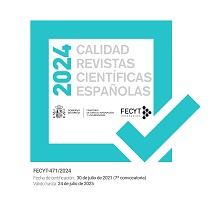Estrategias para involucrar al paciente y a la familia en la mejora de los objetivos de Seguridad del Paciente en el hospital: una revisión del alcance
Agencias de apoyo
- Hasanuddin University
Resumen
Objetivo: Explorar y mapear estrategias para involucrar al paciente y la familia en la mejora de la seguridad del paciente en el hospital, e identificar factores de apoyo e inhibición que influyen en estas estrategias.
Fuente de datos: La revisión de alcance de literatura científica y gris (2014-2024) se realizó siguiendo el marco de Arkey y O’Malley, recopilando estudios de nueve bases de datos y mediante búsqueda manual. Los estudios incluidos se centran en la participación del paciente y la familia en la seguridad del paciente y los desafíos enfrentados. El protocolo del estudio está registrado en el Open Science Framework (https://osf.io/st).
Resultados: Los esfuerzos para involucrar al paciente y la familia incluyen herramientas como listas de verificación, capacitación del personal, programas de comunicación y encuestas de perspectiva del paciente. Los factores de apoyo incluyen educación y capacitación, mientras que los inhibidores son la baja alfabetización en salud y las limitaciones financieras.
Conclusión: La participación del paciente y la familia en la seguridad del paciente ha mostrado avances, pero requiere un enfoque multidimensional. Esto implica educación, capacitación, políticas del sistema y colaboración comunitaria —aún escasa— junto con apoyo financiero e instalaciones adecuadas. Es necesaria mayor investigación para profundizar en los factores que influyen en la participación y las formas de superar los desafíos..
Palabras clave: participación familiar; atención hospitalaria; participación del paciente; objetivos de seguridad del paciente.
Descargas
-
Resumen620
-
ESP_PDF520
-
ENG_PDF 373
-
XML0
Citas
Slawomirski L, Auraaen A KN. The economics of patient safety in primary and ambulatory care: flying blind. OECD Health Working Papers No. 106. Paris: Organisation for Economic Co-operation and Development. 2018;
Slawomirski L, Auraaen A KN. The economics of patient safety: strengthening a value-based approach to reducing patient harm at national level. 2023;accessed 6.
WHO. Patient safety [Internet]. 2023. Available from: https://www.who.int/news-room/fact-sheets/detail/patient-safety
WHO. Global Patient Safety Action Plan 2021–2030. World Heal Organ. 2021;53(9):1689–99.
WHO. 10 facts on patient safety. 2019;
Giap T thanh tinh, Park M. Implementing Patient and Family Involvement Interventions for Promoting Patient Safety : A Systematic Review. 2021;17(2):131–40.
Khan A, Spector ND, Baird JD, Ashland M, Starmer AJ, Rosenbluth G, et al. Patient safety after implementation of a coproduced family centered communication programme: Multicenter before and after intervention study. BMJ. 2018;363.
Haslinda H, Rachmawaty R, Saleh A. Strategies to improve patients’ involvement in achieving patient safety goals: A literature review. Enfermería Clínica. 2021;31:S609–13.
Newman B, Joseph K, Chauhan A, Seale H, Li J, Manias E, et al. Do patient engagement interventions work for all patients? A systematic review and realist synthesis of interventions to enhance patient safety. Heal Expect. 2021 Dec;24(6):1905–23.
Lee M, Lee NJ, Seo HJ, Jang H, Kim SM. Interventions to Engage Patients and Families in Patient Safety: A Systematic Review. West J Nurs Res. 2021 Dec 22;43(10):972–83.
Sharma BAE, Rivadeneira NA, Barr-walker J, Stern RJ, Johnson AK. Patient Engagement In Health Care Safety: An Overview Of Mixed-Quality Evidence. 2018;(November):1813–20.
Mackintosh NJ, Davis RE, Easter A, Rayment-Jones H, Sevdalis N, Wilson S, et al. Interventions to increase patient and family involvement in escalation of care for acute life-threatening illness in community health and hospital settings. Cochrane database Syst Rev. 2020 Dec;12(12):CD012829.
Cai Y, Bs YL, Student G, Zhang M, Jiang RY. Patient and family engagement interventions for hospitalized patient safety : A scoping review. 2024;(August 2023):2099–111.
WHO Member States. Implementation of the Global Patient Safety INTERIM REPORT Based on the first survey of patient safety in WHO Member States. 2023;
Wulandari ARC, Rachmawaty R, Ilkafah I, Erfina E. Patient satisfaction towards healthcare quality in Indonesian Public Hospital. Enfermería Clínica. 2021;31:S745–50.
Chegini Z, Janati A, Babaie J, Pouraghaei M. Exploring the barriers to patient engagement in the delivery of safe care in Iranian hospitals: A qualitative study. Nurs Open. 2020;7(1):457–65.
Russ SJ, Rout S, Caris J, Moorthy K, Mayer E, Darzi A, et al. The WHO surgical safety checklist : survey of patients ’ views. 2014;939–46.
Knowles S, Hays R, Senra H, Bower P, Locock L, Protheroe J, et al. Empowering people to help speak up about safety in primary care: Using codesign to involve patients and professionals in developing new interventions for patients with multimorbidity. Heal Expect. 2018 Apr;21(2):539–48.
Lachman P, Linkson L, Evans T, Clausen H. Developing person-centred analysis of harm in a paediatric hospital : a quality improvement report. 2015;337–44.
Lawton R, Hara JKO, Sheard L, Armitage G, Cocks K, Buckley H, et al. Can patient involvement improve patient safety ? A cluster randomised control trial of the Patient Reporting and Action for a Safe Environment ( PRASE ) intervention. 2017;622–31.
Louch G, Hara JO, Mohammed MA. A qualitative formative evaluation of a patient- centred patient safety intervention delivered in collaboration with hospital volunteers. 2017;(March):1143–53.
Etchegaray JM, Ottosen MJ, Aigbe A, Sedlock E, Sage WM, Bell SK, et al. Patients as Partners in Learning from Unexpected Events. Health Serv Res. 2016 Dec 2;51:2600–14.
Hons NT, Giles S, Hons BA. ORIG INAL RE S E ARCH PAPER A patient and public involvement workshop using visual art and priority setting to provide patients with a voice to describe quality and safety concerns : Vitamin B12 deficiency and pernicious anaemia. 2021;(June 2020):87–94.
Morris RL, Giles S, Campbell S. Involving patients and carers in patient safety in primary care: A qualitative study of a co‐designed patient safety guide. Heal Expect. 2022 Apr;26(2):630–9.
Russ S, Sevdalis N, Ocloo J, Russ S. A Smartphone App Designed to Empower Patients to Contribute Toward Safer Surgical Care : Qualitative Evaluation of Diverse Public and Patient Perceptions Using Focus Groups Corresponding Author : 2021;9.
Louch G, Mohammed MA, Hughes L, O’Hara J. “Change is what can actually make the tough times better”: A patient‐centred patient safety intervention delivered in collaboration with hospital volunteers. Heal Expect. 2019 Feb;22(1):102–13.
Cox ED, Jacobsohn GC, Rajamanickam VP, Carayon P, Wetterneck TB, Rathouz PJ, et al. A Family-Centered Rounds Checklist , Family Engagement , and Patient Safety : A Randomized Trial. 2017;139(5).
Lewis KD, Destino L, Everhart J, Subramony A, Dreyer B, Allair B, et al. Patient and Family-Centered I-PASS SCORE Program: Resident and Advanced Care Provider Training Materials. MedEdPORTAL J Teach Learn Resour. 2022;18:11267.
Goncalves KM de M, Costaa MTTCA, Silva DCB, Baggio ME, Corrêa A dos R, Manzo BF. Ludic strategy for promoting engagement of parents and caregivers in the safety of pediatric patients. 2020;1–8.
Haldar S, Mishra SR, Pollack AH, Pratt W. Informatics opportunities to involve patients in hospital safety : a conceptual model. 2020;27(October 2019):202–11.
Bishop AC, Baker GR, Boyle TA, MacKinnon NJ. Using the Health Belief Model to explain patient involvement in patient safety. Heal Expect. 2015 Dec;18(6):3019–33.
Duckworth M, Adelman J, Belategui K, Feliciano Z, Jackson E, Khasnabish S, et al. Assessing the Effectiveness of Engaging Patients and Their Families in the Three-Step Fall Prevention Process Across Modalities of an Evidence-Based Fall Prevention Toolkit: An Implementation Science Study. J Med Internet Res. 2019 Jan;21(1):e10008.
New L, Goodridge D, Kappel J, Groot G, Dobson R. “ I just have to take it ” – patient safety in acute care : perspectives and experiences of patients with chronic kidney disease. 2019;1–11.
Duhn L, Medves J. A 5‐facet framework to describe patient engagement in patient safety. Heal Expect. 2018 Dec;21(6):1122–33.
Bergerød IJ, Dalen I, Braut GS, Gilje B, Wiig S. Measuring next of kin satisfaction with hospital cancer care: Using a mixed-method approach as basis for improving quality and safety. J Adv Nurs. 2020;76(5):1232–46.
Bergerød IJ, Gilje B, Braut GS, Wiig S. Next-of-kin involvement in improving hospital cancer care quality and safety - A qualitative cross-case study as basis for theory development. BMC Health Serv Res. 2018;18(1).
Harris K, Søfteland E, Moi AL, Harthug S, Storesund A, Jesuthasan S, et al. Patients’ and healthcare workers’ recommendations for a surgical patient safety checklist - a qualitative study. BMC Health Serv Res. 2020 Jan 16;20(1):1–10.
Merner B, Hill S, Taylor M. “ I ’ m Trying to Stop Things Before They Happen ”: Carers ’ Contributions to Patient Safety in Hospitals. 2019;
Newman B, Joseph K, McDonald FEJ, Harrison R, Patterson P. Using consumer engagement strategies to improve healthcare safety for young people: An exploration of the relevance and suitability of current approaches. Heal Expect. 2022 Dec;25(6):3215–24.
Mengozzi C, Campaniello G, Aversa F, Re F, Calatafimi B, Albertini R, et al. The “ Patient ’ s Empowerment rights-duty Charter ”: new communication tools targeted at patient and professionals in a Hematology and Bone marrow transplant center. 2019;90(1):233–40.
Zahrani AK Al, Alaska YA, Alqahtani NM, Alotaibi F. The Impact of a Patient Participating in Evaluating Patient Safety by Using the Patient Measure of Safety in Saudi Arabia : A Cross-Sectional Study. 2023;19(6).
Shin SH, Kim MJ, Moon HJ. Development and Effectiveness of a Patient Safety Education Program for Inpatients. 2021;
Voorden M Van Der, Franx A, Ahaus K. Actions for mitigating the negative effects of patient participation in patient safety : a qualitative study. 2024;1:1–11.
Lewis KD, Destino L, Everhart J, Subramony A, Dreyer B, Allair B, et al. Patient and Family-Centered I-PASS SCORE Program: Resident and Advanced Care Provider Training Materials. MedEdPORTAL J Teach Learn Resour. 2022;18:11267.
Khan A, Spector ND, Baird JD, Ashland M, Starmer AJ, Rosenbluth G, et al. Patient safety after implementation of a coproduced family centered communication programme: multicenter before and after intervention study. BMJ. 2018 Dec;363:k4764.
Bergerød IJ, Braut GS, Fagerdal B, Gilje B, Wiig S. Developing a Next-of-Kin Involvement Guide in Cancer Care — Results From a Consensus Process. 2021;44(6):447–57.
Duhn L, Medves J, Dean V. ORIG INAL RESE ARCH PAPER A 5- facet framework to describe patient engagement in patient safety. 2018;(January):1122–33.
Chegini Z, Arab-Zozani M, Shariful Islam SM, Tobiano G, Abbasgholizadeh Rahimi S. Barriers and facilitators to patient engagement in patient safety from patients and healthcare professionals’ perspectives: A systematic review and meta-synthesis. Nurs Forum. 2021 Oct;56(4):938–49.
Bergerød IJ, Gilje B, Braut GS, Wiig S. Next-of-kin involvement in improving hospital cancer care quality and safety - a qualitative cross-case study as basis for theory development. BMC Health Serv Res. 2018 May;18(1):324.
Goodridge D, Mcdonald M, New L, Scharf M, Harrison E, Rotter T, et al. Building patient capacity to participate in care during hospitalisation: A scoping review. BMJ Open. 2019;9(7).
Derechos de autor 2025 Enfermería Global

Esta obra está bajo una licencia internacional Creative Commons Atribución-NoComercial-SinDerivadas 4.0.
Las obras que se publican en esta revista están sujetas a los siguientes términos:
1. El Servicio de Publicaciones de la Universidad de Murcia (la editorial) conserva los derechos patrimoniales (copyright) de las obras publicadas, y favorece y permite la reutilización de las mismas bajo la licencia de uso indicada en el punto 2.
© Servicio de Publicaciones, Universidad de Murcia, 2018
2. Las obras se publican en la edición electrónica de la revista bajo una licencia Creative Commons Reconocimiento-NoComercial-SinObraDerivada 4.0 España (texto legal). Se pueden copiar, usar, difundir, transmitir y exponer públicamente, siempre que: i) se cite la autoría y la fuente original de su publicación (revista, editorial y URL de la obra); ii) no se usen para fines comerciales; iii) se mencione la existencia y especificaciones de esta licencia de uso.
3. Condiciones de auto-archivo. Se permite y se anima a los autores a difundir electrónicamente las versiones pre-print (versión antes de ser evaluada y enviada a la revista) y/o post-print (versión evaluada y aceptada para su publicación) de sus obras antes de su publicación, ya que favorece su circulación y difusión más temprana y con ello un posible aumento en su citación y alcance entre la comunidad académica. Color RoMEO: verde.












